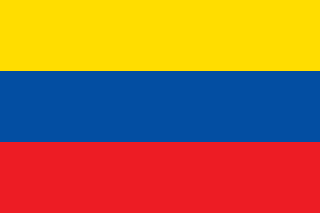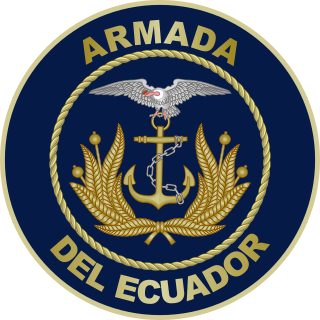Related Research Articles

Guayaquil, officially Santiago de Guayaquil, is the largest city in Ecuador and also the nation's economic capital and main port. The city is the capital of Guayas Province and the seat of Guayaquil Canton. The city is located on the west bank of the Guayas River, which flows into the Pacific Ocean at the Gulf of Guayaquil.

Guayas is a coastal province in Ecuador. It is bordered to the west by Manabí, Santa Elena, and the Pacific Ocean ; to the east by Los Ríos, Bolívar, Chimborazo, Cañar, and Azuay; to the north by Los Ríos and Bolívar; and to the south by El Oro and the Pacific Ocean.

Alfredo Pareja Diezcanseco — born Alfredo Pareja y Díez Canseco — was a prominent Ecuadorian novelist, essayist, journalist, historian and diplomat. An innovator of the 20th-century Latin American novel, he was a founding member of the literary Grupo de Guayaquil, which brought a new emphasis to realistic novels.

Julio Alfredo Jaramillo Laurido was a notable Ecuadorian singer and recording artist who performed throughout Latin America, achieving great fame for his renditions of boleros, valses, pasillos, tangos, and rancheras.
Jorge Velarde is a Contemporary Latin American painter from Ecuador. Velarde has been drawing and painting since he was a child. At the age of 15 Velarde knew that he was meant to be a painter.
Marcos Restrepo Restrepo is a Latin American painter who is a member of the artist group Artefactoría, founded by Xavier Patiño. Artefactoría was formed in 1982 by a group of painters from the School of Fine Arts in Guayaquil who are inspired by the surrealists and the unconscious. Members of Artefactoria include: Restrepo, Xavier Patiño, Jorge Velarde, Pedro Dávila, Marco Alvarado, Flavio Álava, Paco Cuesta
Pasillo is a Colombian genre of music extremely popular in the territories that composed the 19th century Viceroyalty of New Granada: Born in the Colombian Andes during the independence wars, it spread to other areas; especially Ecuador and, to a lesser extent, the mountainous regions of Venezuela and Panama. Venezuelans refer to this style of music as "vals". Today, it has incorporated more European features of classical dance, such as Viennese waltz in Colombia and features of sanjuanito and yaraví in Ecuador. As it spread during the Gran Colombia period, pasillo also absorbed the individual characteristics of isolated villages. This gives it an eclectic feel; however, the style, tone, and tempo of the music differ in each village and indeed between each country.

Ratas, ratones, rateros is a 1999 Ecuadorian film directed by Sebastián Cordero and starring Carlos Valencia and Marco Bustos. It was shown at the 1999 Bogotá Film Festival but did not receive a wide release until 2001. It was nominated for Best Film of the Year in 2001 by the Spanish Goya Awards. It was described as the first Ecuadorian film with international-standard production values.

The Ecuadorian–Peruvian War took place between 1857 and 1860. The conflict began when Ecuador attempted to sell Amazon basin land claimed by Peru in order to settle a debt with British creditors. When diplomatic relations between the two countries broke down, prior to the fragmentation of the Ecuadorian government into several competing factions, the Peruvian government ordered a blockade of Ecuador's ports in order to force the cancellation of the sale, and the official acknowledgement of Peruvian ownership of the disputed territories. By late 1859, control of Ecuador was consolidated between General Guillermo Franco, in the city of Guayaquil, and a provisional government in Quito headed by Gabriel García Moreno. Peruvian President Ramón Castilla sailed to Guayaquil with several thousand soldiers in October 1859, and negotiated the Treaty of Mapasingue with General Franco in January 1860. The signing of the treaty indicated Ecuadorian compliance with all of Peru's demands, and temporarily marked the end of the territorial dispute between the two countries. However, in September 1860, the forces of the provisional government, commanded by García Moreno and General Juan José Flores defeated Franco's government at the Battle of Guayaquil, ending the civil war in Ecuador. The new government disavowed the Treaty of Mapasingue, followed shortly afterwards by its Peruvian counterpart; this re-opened the territorial dispute.

The climate of Ecuador is generally tropical and varies with altitude and region, due to differences in elevation and, to a degree, in proximity to the equator.

The history of the Republic of Ecuador from 1830 to 1860 begins with the collapse of the nation of Gran Colombia in 1830, followed by the assassination of Antonio José de Sucre and the death of Simón Bolívar from tuberculosis the same year. Heartbroken at the dissolution of Gran Colombia, Bolívar is quoted to have said shortly before his death, "America is ungovernable. Those who have served the revolution have plowed the sea." These words would seem prophetic during the chaotic first thirty years in the existence of Ecuador.

Cyrano Fernández is a 2007 Venezuelan drama film based on the 1897 play Cyrano de Bergerac by Edmond Rostand, but set in contemporary times.
Nicasio Safadi Reves (Reves is the translation of Rbeiz) (1902 – October 29, 1968 in Guayaquil) was an Ecuadorian musician

The Liberal Revolution of 1895 took place in Ecuador, and was a period of radical social and political upheaval. The Revolution started on June 5, 1895 and ultimately resulted in the overthrow of the conservative government, which had ruled Ecuador for several decades, by the Radical Liberals, led by Eloy Alfaro. After the revolution, the new government legalized divorce, allowed religious freedom, and weakened the authority of the Church, which lost the land it held.

BAE Abdón Calderón is a naval ship of Ecuador, built in 1885 and now preserved as a museum ship at Guayaquil.

The Ecuadorian Navy is an Ecuadorian entity responsible for the surveillance and protection of national maritime territory and has a personnel of 9,400 men to protect a coastline of 2,237 km which reaches far into the Pacific Ocean. The vessels are identified by a ship prefix of B.A.E.: Buque de la Armada del Ecuador or L.A.E.: Lancha de la Armada del Ecuador.
Dawn in Pichincha is a 1950 Ecuadorian drama film directed by Alberto Santana and starring Paul Feret, Martha Jácome and Salomón Rosero. It was the second sound film to be made in Ecuador following They Met in Guayaquil which was released the previous year.
Alberto Santana (1897–1966) was a Chilean screenwriter and film producer. He directed twenty five films during a career that took him to several countries. Santana was important in developing Ecuadorian cinema, producing They Met in Guayaquil (1949) and directing Dawn in Pichincha (1950) the first and second Ecuadorian sound films.
The 1922 Guayaquil general strike was a three-day general work stoppage in the city of Guayaquil, Ecuador, which lasted from 13 to 15 November of that year. The strike began with trolley, electric company and other public utility workers who were inspired by a successful strike by railroad workers in nearby Durán. Workers made demands such as pay increases, shorter hours, safer working conditions, and government control of foreign currency exchange rates.
Events in the year 2021 in Ecuador.